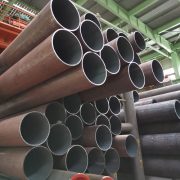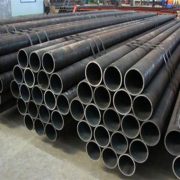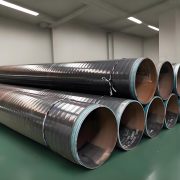Introduction
In industries like oil and gas, petrochemicals, offshore engineering, and machinery manufacturing, the choice between hot-rolled seamless steel pipe and cold-rolled/drawn seamless steel pipe plays a critical role in determining the performance, durability, and cost-efficiency of equipment and projects. With demanding requirements for dimensional accuracy, mechanical properties, and durability, choosing the right pipe type that suits specific applications and environmental challenges is essential.
This guide will provide an in-depth comparison of hot-rolled seamless steel pipes and cold-rolled/drawn seamless steel pipes, highlighting the manufacturing processes, mechanical properties, and typical use cases for each. The goal is to help you make informed decisions that meet your project’s needs.
Understanding Seamless Steel Pipes
Before discussing the differences between hot-rolled and cold-rolled/drawn seamless steel pipes, it’s’ important to understand what seamless steel pipes are.
Seamless steel pipes are manufactured without welding, adding strength and uniformity. This makes them ideal for high-pressure applications like gas pipelines, oil wells, and hydraulic systems. Their seamless construction minimizes the risk of leakage and provides superior resistance to corrosion and mechanical stress.
Now, let’s examine the difference between hot-rolled and cold-rolled/-drawn processes and their impact on the final product.
Manufacturing Process: Hot-Rolled vs Cold-Rolled/Drawn Seamless Steel Pipe
Hot-Rolled Seamless Steel Pipes
Hot-rolling involves heating the steel billet above its recrystallization temperature (typically over 1,000°C). The billet is then pierced and rolled into the shape of a pipe through a set of rollers. After forming, the hot-rolled pipe is cooled at room temperature, which may lead to slight variations in shape and size.
The process is quicker and more efficient for producing large-diameter pipes, but the finished product typically requires further treatment if tighter tolerances and surface finishes are needed.
Cold-Rolled/Drawn Seamless Steel Pipes
Cold-rolling or cold-drawing starts with a hot-rolled pipe that undergoes additional processing at room temperature. During cold-rolling or cold drawing, the steel pipe is passed through a die or drawn over a mandrel, which reduces its diameter and thickness. This process results in a more refined surface finish and tighter dimensional tolerances.
The cold-rolling/drawing process increases the pipe’s strength through strain hardening, producing pipes with superior mechanical properties, such as higher tensile strength and better resistance to deformation.
Critical Differences: Hot-Rolled and Cold-Rolled/Drawn Seamless Steel Pipe
The two types of seamless pipes offer different advantages, depending on the application. Here’s a breakdown of the critical differences in properties:
1. Strength and Durability
- Due to the high temperatures at which they are formed, hot-rolled seamless steel pipes have a relatively low yield strength and hardness. They are typically less intense but more ductile, making them suitable for applications where flexibility and resistance to shock loads are essential, such as structural components or low-pressure pipelines.
- Due to the cold-working process, cold-rolled/drawn seamless steel pipes are more robust and more complex. Their higher tensile strength makes them suitable for high-pressure applications, such as hydraulic systems, heat exchangers, and precision engineering components where strength and tight tolerances are critical.
2. Surface Finish
- Hot-rolled pipes usually have a rough, scaled surface finish, which may require further machining or treatment if a smooth surface is needed. The scale formation results from cooling at room temperature, which is acceptable in many structural applications but unsuitable for applications requiring a soft, aesthetic finish.
- Cold-rolled/drawn pipes, on the other hand, have a much smoother surface finish due to the absence of high-temperature scaling. This makes them a preferred choice for components that require excellent surface quality, such as in machinery manufacturing and automotive industries.
3. Dimensional Accuracy
- Due to the high-temperature manufacturing process, hot-rolled seamless steel pipes tend to have looser dimensional tolerances. While they can be used in applications where precision isn’t’ paramount, they are less suitable for projects that demand exact sizing.
- Cold-rolled/drawn seamless steel pipes offer superior dimensional accuracy with much tighter tolerances. This is critical in applications such as hydraulic cylinders, precision machinery, and piping systems where fittings must be exact to avoid leaks or failures.
4. Mechanical Properties
- Hot-rolled pipes are more malleable and easily welded, making them ideal for applications with flexibility over strength, such as construction or low-pressure gas transmission.
- Cold-rolled/drawn pipes exhibit higher mechanical strength and toughness, making them better suited for high-pressure environments like power plants, chemical processing, and oil and gas refineries. They can withstand significant stress and pressure without deforming.
5. Cost Considerations
- Hot-rolled seamless pipes are generally more economical to produce, especially for large-diameter applications. If cost efficiency is a primary concern and the project does not require tight tolerances or high surface quality, hot-rolled pipes may be the best option.
- Cold-rolled/drawn seamless pipes are more expensive due to the additional processing required to achieve higher strength, accuracy, and finish. However, for high-precision projects or those involving high-pressure systems, the added cost is justified by the performance benefits.
Applications
Different industries have varying requirements for seamless steel pipes, and the choice between hot-rolled and cold-rolled/drawn depends on these specific demands.
Oil & Gas Industry
Hot-rolled seamless pipes are often used for low-pressure transmission pipelines in the oil and gas. In contrast, cold-rolled/-drawn pipes are preferred for high-pressure piping systems, such as those used in offshore drilling platforms or hydraulic fracturing equipment.
Petrochemicals
The petrochemical industry requires pipes with exceptional corrosion resistance and mechanical strength. In highly corrosive environments, cold-rolled/-drawn seamless pipes are commonly chosen for heat exchangers, pressure vessels, and piping systems.
Machinery Manufacturing
Cold-rolled/-drawn seamless steel pipes are favored in machinery manufacturing due to their high precision, strength, and smooth surface finish. They are often used in hydraulic cylinders, automotive components, and other critical machinery where tight tolerances and high strength are essential.
Offshore Engineering
Offshore engineering projects, including subsea installations, demand pipes that withstand harsh environmental conditions, including saltwater corrosion and extreme pressures. Cold-rolled/drawn pipes with enhanced mechanical properties and dimensional accuracy are typically preferred in these settings, especially in critical components like riser systems and flowlines.
Solving Common Challenges
Selecting suitable pipes for specific applications can address many common challenges in industries such as oil, gas, petrochemicals, and machinery manufacturing.
Challenge 1: Dimensional Accuracy
Cold-rolled/drawn seamless steel pipes are highly recommended in applications where precise measurements are vital, such as hydraulic systems or precision machinery. Their tight tolerances and refined surface finish minimize the risk of fitting errors and potential leaks.
Challenge 2: Surface Quality
Cold-rolled/drawn pipes often provide a smooth, polished surface without additional post-processing for applications requiring high-quality finishes, such as automotive parts or medical equipment.
Challenge 3: Strength Under Pressure
Cold-rolled/drawn seamless pipes are ideal for high-pressure environments. Their superior strength and resistance to deformation ensure that they can withstand the significant mechanical stresses encountered in applications like oil extraction or chemical processing.
Challenge 4: Cost Management
Suppose the project’s budget is a primary concern, and tight tolerances are not critical. In that case, hot-rolled seamless steel pipes offer a cost-effective solution, especially in large-scale structural or low-pressure applications.
Conclusion: Choosing the Right Seamless Steel Pipe
Hot-rolled seamless steel pipes and cold-rolled/drawn seamless steel pipes have their place in various industries, depending on the project’s specific requirements. Hot-rolled pipes are ideal for applications prioritizing cost-effectiveness and flexibility, while cold-rolled/drawn pipes offer enhanced strength, precision, and surface quality.
When choosing between the two, consider the key factors such as mechanical strength, dimensional accuracy, surface finish, and cost to ensure optimal performance and longevity in your application. Each type of seamless pipe serves a unique purpose, and the right choice can significantly improve the efficiency and reliability of your project.




